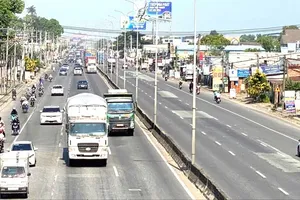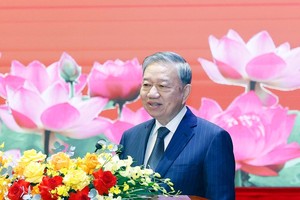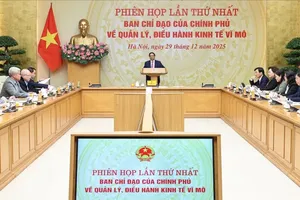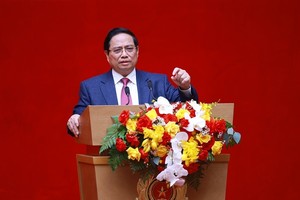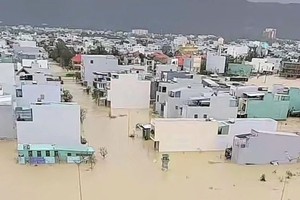 |
Standing Member of Economic Committee of the National Assembly Phan Duc Hieu at the workshop |
At the workshop ‘Green finance and carbon credit market’ organized by SGGP Newspaper on September 6, managers and experts said that Vietnam is increasingly concerned about environmental issues and climate change with a strong commitment to the international community on net-zero emissions – the country’s economy either emits no greenhouse gas emissions or offsets its emissions, by 2050.
Sharing at the conference, Director of the National Strategy for Development of Digital Economy Tran Van said that in the face of extreme developments in climate change, the problem of environmental pollution, and greenhouse gas emissions, financial markets around the world have quickly grasped the trend of clean, green development and introduced many proper financial tools.
According to information from the Climate Bonds Initiative (CBI), about US$2,334 billion of green bonds have been issued by 2023, equal to 5 percent of the value of the global debt market, and is expected to reach US$5,000 billion by 2025.
In Vietnam, the Green Growth Strategy for the period 2011-2020 and vision to 2050 focuses on reducing the intensity of greenhouse gas emissions and promoting the use of clean energy and renewable energy, greening production, greening lifestyles, and promoting sustainable consumption.
The National Assembly’s Resolution 98/2023 allows Ho Chi Minh City to issue green bonds to partially or fully invest in renewable energy projects such as offshore wind power in the Can Gio coastal area, renewable and clean energy projects, waste-to-energy projects converting household garbage into electricity, projects to dredge and revive canals and embankments, flood protection projects and projects on climate change adaptation
In addition to the green bond market, lecturer Ho Quoc Tuan from Bristol University affirmed that green credit is a common and inevitable trend in the world. In particular, green credit provides capital with preferential interest rates for projects that create good impacts on the environment. Green credit, when used effectively, can direct capital to projects that directly contribute to emissions reduction commitments of the industry in general and of Ho Chi Minh City in particular.
The research team from Ho Chi Minh City University of Economics and Bristol University also said that the dual transformation (green and digital) has been an important future trend, the quantity and quality of green projects in the coming years will increase significantly, requiring the green bond market needs to develop more. To direct capital flows to emission reduction projects, access to opportunities from green bonds, green loans and domestic and international carbon markets is important.
Many experts voiced their opinion that the supportive connection between green finance and the carbon credit market will help accelerate the transition to a more sustainable green economy following the global trend.
However, due to many reasons, credit institutions lending for green projects in the textile and garment industries, clean agriculture, renewable energy and environmental sanitation only reached nearly VND500,000 billion (US$20,855,088,040) by the end of 2022, accounting for about 4.2 percent of total economic debt meanwhile, the carbon credit trading market in Vietnam is only in the process of being built, without the necessary legal system.
According to experts, if the carbon credit market structure is not formed soon, it will not only limit green financial opportunities but also may slow down the net-zero emissions process. Therefore, Ho Chi Minh City needs to have a carbon trade exchange where businesses can purchase and trade carbon credits. Thus, the green bond market itself must go with the carbon credit market, and they support each other at the same time, said lecturer Ho Quoc Tuan.
According to teacher Nguyen Thi Thu Ha from Ho Chi Minh City University of Economics, as a financial center, Ho Chi Minh City needs to develop policy incentives that reduce barriers to entry for green credit, through subsidies for compensation to cover risks and guarantee funding, as well as support transaction costs related to green bond issuance for issuers.
In particular, Ho Chi Minh City needs to take advantage of incentives given by the Resolution 98/2023/QH15 to lead international capital flows into Vietnam, through promoting solutions to improve the market structure and connect the green and voluntary bond market markets in the country and the region.
Assessing the green financial market in Vietnam, economist Nguyen Tri Hieu said that many years ago, the Government approved the Strategy on Green Growth for the 2021-2030 period. However, up to now, just a few banks giving loans for environmental protection, and green bonds in Vietnam are not many. This situation shows that the issue of green finance and green bonds is still new in Vietnam; thus, for green bonds to be more popular in Vietnam, four issues including how to use capital, for what works and projects, projects’ strict evaluation , transparency of reports from publishers, auditing companies, and authorities. Moreover, investors ought to be told how bond issuers manage capital flows to have a source of repayment for bonds.
Dr. Nguyen Tri Hieu suggested that the Ministry of Finance and the Ministry of Natural Resources and Environment need to come up with criteria and standards for green bonds so that businesses can apply.



